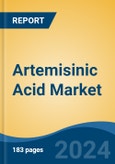Antimalarial Tablets is the fastest growing segment, Middle East & Africa is the largest regional market
Speak directly to the analyst to clarify any post sales queries you may have.
10% Free customizationThis report comes with 10% free customization, enabling you to add data that meets your specific business needs.
The market’s expansion is robustly supported by several key drivers, including the persistent global burden of malaria, which sustains the demand for artemisinin-based combination therapies, and continuous advancements in biotechnological production methods like microbial fermentation, offering enhanced supply chain reliability and cost predictability. Furthermore, increasing investments in research and development exploring diverse therapeutic applications beyond malaria also contribute to market growth.
Key Market Drivers
The global artemisinic acid market is significantly influenced by the persistent burden of malaria worldwide and continuous advancements in biotechnological production methods. The enduring health crisis of malaria consistently drives demand for artemisinin-based combination therapies, which in turn elevates the need for artemisinic acid as a crucial precursor. The crisis necessitates a steady supply of effective antimalarial drugs.According to the World Health Organization (WHO), in December 2024, the Malaria Report stated that global malaria cases reached an estimated 263 million in 2023, underscoring the vast and ongoing need for treatment. Simultaneously, advancements in biotechnological production methods significantly enhance supply chain reliability and cost predictability for artemisinic acid. Synthetic biology innovations, particularly engineered microbial fermentation, revolutionize manufacturing.
Key Market Challenges
The emergence of artemisinin resistance in malaria parasites poses a significant challenge to the Global Artemisinic Acid Market. This resistance directly undermines the efficacy of artemisinin-based combination therapies, which are currently pivotal for malaria treatment. As parasites develop resistance, the sustained effectiveness of these essential drugs is jeopardized, leading to reduced confidence in artemisinin as a reliable active pharmaceutical ingredient. This instability threatens the consistent demand for artemisinic acid, its key precursor.Developing new antimalarial drugs to overcome this resistance represents a substantial financial burden on the pharmaceutical industry. According to the European Federation of Pharmaceutical Industries and Associations (EFPIA), the estimated cost for researching and developing a new chemical or biological entity was €3.13 billion (equivalent to $3.29 billion in 2022 dollars) in 2022. This considerable investment, required for ongoing innovation to counteract resistance, diverts resources and increases development timelines, thereby impeding stable market growth for established precursors like artemisinic acid.
Key Market Trends
The prioritization of sustainable production processes is emerging as a critical trend within the global artemisinic acid market. This focus extends beyond mere compliance, reflecting a concerted effort across the pharmaceutical industry to minimize environmental impact and promote ethical manufacturing practices throughout the supply chain. Companies are increasingly investing in green chemistry principles, adopting renewable energy sources, and implementing waste reduction strategies to enhance their ecological footprint. According to Cytiva's 2024 Global Biopharma Sustainability Review, sustainability ranks as the number one priority for 62% of biopharma companies over the next five years, indicating a significant shift towards environmentally conscious operations. This commitment drives innovation in manufacturing techniques, promoting resource efficiency and a reduced reliance on hazardous materials in the production of key pharmaceutical precursors like artemisinic acid.Key Market Players Profiled:
- Sanofi SA
- KPC Pharmaceuticals, Inc
- Guilin Pharmaceutical Co., Ltd
- Calyx Chemicals and Pharmaceuticals Ltd.
- Novartis AG
- Ipca Laboratories Ltd.
- Cipla Inc.
- Shin Poong Pharm Co., Ltd.
- Rupus Global Limited
- AdvacarePharma
Report Scope:
In this report, the Global Artemisinic Acid Market has been segmented into the following categories:By Type:
- Total Synthesis
- Semi synthesis
By Applications:
- Antimalarial Injections
- Antimalarial Tablets
By Region:
- Middle East & Africa
- Asia-Pacific
- South America
- Europe
- North America
Competitive Landscape
Company Profiles: Detailed analysis of the major companies present in the Global Artemisinic Acid Market.Available Customizations:
With the given market data, the publisher offers customizations according to a company's specific needs. The following customization options are available for the report.Company Information
- Detailed analysis and profiling of additional market players (up to five).
This product will be delivered within 1-3 business days.
Table of Contents
Companies Mentioned
The companies profiled in this Artemisinic Acid market report include:- Sanofi SA
- KPC Pharmaceuticals, Inc
- Guilin Pharmaceutical Co., Ltd
- Calyx Chemicals and Pharmaceuticals Ltd.
- Novartis AG
- Ipca Laboratories Ltd.
- Cipla Inc.
- Shin Poong Pharm Co., Ltd.
- Rupus Global Limited
- AdvacarePharma
Table Information
| Report Attribute | Details |
|---|---|
| No. of Pages | 183 |
| Published | November 2025 |
| Forecast Period | 2024 - 2030 |
| Estimated Market Value ( USD | $ 521.9 Million |
| Forecasted Market Value ( USD | $ 664.57 Million |
| Compound Annual Growth Rate | 4.1% |
| Regions Covered | Global |
| No. of Companies Mentioned | 11 |









